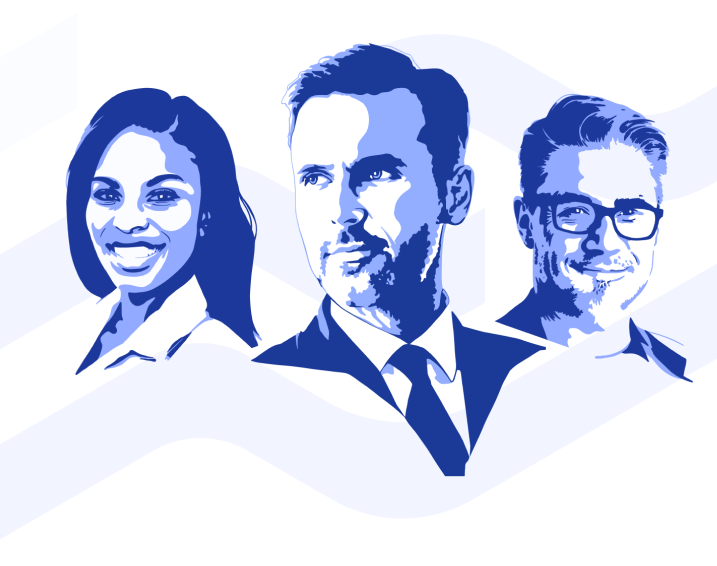Interim & Fractional CIOs, CTOs, and CISOs for Technology/SaaS Organizations
Leverage our Technology Leadership Experts to:
- Deliver scalable growth
- Accelerate product innovation
- Reduce technical debt
- Strengthen cybersecurity






5 Benefits of Technology/SaaS‑Focused Organizations
- 1 Accelerated Innovation & Development Velocity
- 2 Reduced Operational Costs & Technical Debt
- 3 Business Resilience & Strategic Risk Mitigation
- 4 Competitive Edge & Future‑Ready Capabilities
- 5 Executive‑Level Technology Leadership On Demand
1 Accelerated Innovation & Development Velocity
- SaaS firms guided by experienced CTOs - from fractional to interim - unlock faster delivery of new features and capabilities. One healthcare SaaS client transformed from a stalled three-month initiative to over 40 feature releases per month within six weeks.
- With CTO-led automation (e.g., testing, deployment, bug triage), development teams shift from tactical tasks to high-value innovation-focused work.
2 Reduced Operational Costs & Technical Debt
- CTO interventions optimize technology budgets by renegotiating vendor contracts, streamlining development teams, and reducing overstaffing or inefficient resources.
- Strategic architecture and microservices guidance under CTO leadership minimize technical debt and improve maintainability and scalability over time.
3 Business Resilience & Strategic Risk Mitigation
- CTOs restore project momentum, fix systemic development issues, and rebuild trust among clients facing delays or IP risk - preserving relationships and outcomes.
- Deep experience in compliance, secure architecture, and governance means reduced exposure to security breaches, regulatory gaps, or integration failures.
4 Competitive Edge & Future‑Ready Capabilities
- Organizations guided by CTO leadership evolve towards usage-based pricing models and embed AI Agents to improve UX, reduce manual effort up to 50%, and enable new monetization strategies.
- This proactive approach positions SaaS companies ahead of peers still operating in legacy or subscription-only models - opening up greater M&A valuation upside and longer-term relevance.
5 Executive‑Level Technology Leadership On Demand
- Fortium’s model provides access to CTO-level leadership as needed: virtual (advisory), fractional (20–80% commitment), or interim (full-time), without hiring overhead or search delays.
Top Challenges Fortium Solves for Your Technology/SaaS Business
THE CHALLENGE
Technology Leadership Gaps & Talent Shortages
- Lack of senior technology leadership (CIO, CTO, CISO) when firms can’t attract, retain, or afford full-time execs.
- Hiring delays - key roles taking six months or longer remain unfilled, causing strategic stagnation.
FORTIUM’S SOLUTION
- They fill such gaps with fractional, interim, or virtual leaders, delivering high-level capability quickly and as-needed
THE CHALLENGE
Scalability & Rapid Growth Issues
- Companies growing quickly often face data sprawl (multiple apps, redundant input), capacity constraints, and inability to scale IT to business needs.
FORTIUM’S SOLUTION
- Fortium helps build strategic roadmaps, align technology systems, and choose better vendors to support 20–25%+ annual growth.
THE CHALLENGE
Broken Product/Digital Initiatives
- SaaS and technology firms endure project delays, ineffective vendor-managed development, misaligned scope, and IP risks.
FORTIUM’S SOLUTION
- Solutions involve deploying fractional CTOs to re-staff teams, restructure workflow, enforce project governance, and restore client confidence.
THE CHALLENGE
Fragmented Systems & Lack of Data Integration
- Many firms operate on siloed apps, inflexible architecture, and little business insight - hindering growth.
FORTIUM’S SOLUTION
- Interim CIOs embed AI‑powered BI, unified system design and predictive analytics to boost revenue and decision-making (e.g., 5% top-line uplift).
THE CHALLENGE
Cybersecurity & Emerging Threats
- Challenges include inadequate Managed Security Service Providers (MSSPs), high IT leadership turnover, and exposure to modern threats like AI deepfakes.
FORTIUM’S SOLUTION
- Fortium offers fractional CISOs, tabletop exercises, board-level governance, incident planning, and hands-on risk mitigation.
3 Reasons Your SaaS Company May Not Have a CTO
Examine the 3 main reasons your company doesn't have a CTO and decide if it's finally time to hire one.
Core Areas of Technology/SaaS Expertise
Fortium CTOs deliver product excellence and operational maturity across five key technical domains:
Tech Leadership Gaps & Talent Shortages
- Strategic alignment with Product Management and Revenue teams
- M&A technology due diligence and integration planning
- Organizational structure design and team hiring strategy
AI & Emerging Tech Leadership
- Applied AI and ML solutions for business workflows
- Data science strategy, NLP, computer vision, and predictive modeling
- Blockchain, quantum computing, and immersive tech readiness
Product Development & Engineering Excellence
- Agile product strategy, team velocity optimization, and technical debt reduction
- Full product lifecycle leadership, from MVP to scaled release
- DevSecOps integration for secure, rapid feature deployment
- Cloud-native architecture, SaaS scalability, and platform modernization
Infrastructure & Delivery Optimization
- Infrastructure as Code (IaC), performance tuning, and uptime assurance
- Cost-efficient cloud deployment strategies (AWS, Azure, GCP)
- CI/CD pipelines, observability, and production incident response
Cybersecurity & Compliance
- SaaS security architecture, DevSecOps, and regulatory alignment
- Risk mitigation, IP protection, and customer trust enablement
- Collaboration with CISO leadership on compliance and threat response
Why Choose Fortium for Technology Leadership?
In a sector defined by speed, scale, and disruption, finding the right technology leader is critical. Fortium’s seasoned CTOs have built, scaled, and secured software products for some of the most successful technology creators in the world. We understand the dynamics of SaaS growth, agile delivery, infrastructure management, and product-market fit - and we bring that experience to every engagement.
Our flexible Technology Leadership-as-a-Service model means you get access to executive-level leadership exactly when and how you need it - without the delay, risk, or cost of a full-time hire.

Our Impact in the Technology/SaaS Industry
Successful Engagements in Technology Companies
Experienced CTOs and Technology Leaders
Client Satisfaction Rate
Focus on Business
Outcomes, Not Buzzwords

What Makes Fortium CTOs Different?
- Proven experience in B2B and B2C SaaS
- Strong relationships with Product, Marketing, Sales, and the Board
- Ability to build and mentor high-performing engineering teams
- Focused on results: measurable growth, delivery metrics, customer experience, and long-term sustainability
FORTIUM CTO PARTNERS
Proven Technology Leaders Driving Growth and Innovation
Engage experienced CTO partners—virtual, fractional, or interim—to accelerate product velocity, optimize costs, manage risk, and align strategy with long-term success.
Resources & Insights
.png?width=591&height=412&name=Door%20of%20a%20new%20contemporary%20office%20building%201%20(1).png)
EBOOK
The CEO’s Guide to Hiring a CTO
This ebook outlines what CTOs do, the value they bring to businesses, and the key considerations CEOs must keep in mind when hiring for this pivotal role.
.png?width=591&height=412&name=Door%20of%20a%20new%20contemporary%20office%20building%201%20(2).png)
BLOG
Adapt or Perish: Why SaaS CEOs Must Embrace AI Agents
The SaaS landscape continues advancing at a steady pace, yet there’s one technology that’s advancing even faster...
.png?width=591&height=412&name=Door%20of%20a%20new%20contemporary%20office%20building%201%20(3).png)
.png?width=591&height=412&name=Door%20of%20a%20new%20contemporary%20office%20building%201%20(4).png)
VIDEO
What is the One Simple Question CEOs Must Ask that Determines the Need for a CIO or a CTO? (or Both)
Are you a SaaS CEO looking to hire or supplement your technology leadership with a CTO?
In his new video, CEO/CTO Burke Autrey explains everything you need to know and more.
Frequently Asked Questions
Have questions? We're here to help
A fractional/interim/virtual technology executive is a senior leader (CTO, CIO, or CISO) engaged on a part-time, temporary, or advisory basis rather than full-time. Fortium offers these roles so you can access executive-level capacity without the time, risk, or cost of a full-time hire. We describe this as Technology Leadership-as-a-ServiceR.
You might need a fractional/interim/virtual CTO when:
- Your organization lacks senior technology leadership, and recruitment is taking too long or is infeasible;
- You are scaling rapidly, and existing leadership can’t keep up with demand;
- You need a leader to manage a turnaround, stabilize operations, or lead a transformation;
- You want executive direction in cybersecurity, governance, or compliance but don’t require a full-time CISO.
Many firms lack a CTO simply because they haven’t prioritized it or assume they can scale without one - and this gap can limit product velocity or architectural maturity.
Fortium can move fast: within hours to days, with an actual start date typically within one to two weeks.
In practice, the exact timeline depends on the seniority of the role, domain specificity (e.g., AI, SaaS platform complexity), and how quickly both parties can finalize agreements and scope. Fortium’s advantage is access to a deep bench of 180+ vetted leaders, which accelerates matching.
Yes. Fortium’s offering includes hands-on technical leadership in product development, engineering excellence, architecture design, and debt remediation. We highlight case studies like turning a stalled initiative into rapid feature releases within weeks (e.g., “from a stalled three-month initiative to over 40 feature releases per month in six weeks”).
As, a Fortium CTO works with you and your organization, s/he may:
- Reassess and reshape architecture (e.g., microservices, modularization, refactoring);
- Introduce DevSecOps, CI/CD, test automation, monitoring, and observability;
- Improve product–engineering alignment, governance, and backlog prioritization;
- Mentor or reorganize engineering teams, bring in missing capabilities, or re-staff as needed.
They are positioned to both lead repairs and scale forward, not just stabilize legacy systems.
Some of the key advantages include:
- Speed & time-to-value – You bypass lengthy executive search cycles and start delivering leadership quickly.
- Flexibility & risk mitigation – You can scale up or down depending on need, or terminate after the project/phase.
- Cost efficiency – You avoid the full burden of salary, benefits, recruiter fees, and onboarding risk.
- Access to expertise – Fortium’s leaders bring deep domain knowledge (SaaS, cybersecurity, AI) and cross-industry experience.
- Outcomes focus – Because the engagement is scoped, there is strong alignment to measurable results (velocity, technical debt reduction, risk mitigation).
Fortium’s resource center compares Executive Search vs. Leadership-as-a-Service as a key consideration for CEOs.
That said, if your company needs a permanent, culture-embedded CTO from Day 1 and has time to recruit, that route still may be appropriate; Fortium can also help with transition or interim bridging.
Fortium positions several SaaS-specific values in their industry landing pages:
- Accelerating innovation and feature velocity - guiding development teams to shift from maintenance or tactical fixes to user-driven innovation.
- Reducing technical debt and optimizing operations - rationalizing legacy code, streamlining vendor portfolios, and right-sizing architecture.
- Strengthening cybersecurity and compliance - establishing DevSecOps, architecture with responsiveness to risk, and governance.
- Scaling and data integration - breaking down silos, unifying systems, embedding predictive analytics, and enabling business intelligence.
- Enabling new monetization and AI strategies - helping SaaS firms adopt usage-based models, embed AI agents, and differentiate vs. legacy peers.
Our CTO leaders understand the dynamics of SaaS growth, agile delivery, infrastructure management, and product-market fit (PMF).
Because of this focus, Fortium is positioned not just as generic technology leadership but as leaders who “speak SaaS.”
Engagements vary depending on the objective - they may be short-term (3 to 6 months) for stabilization, or longer (12+ months) for transformation and scaling. Fortium’s flexible model allows for virtual, fractional, or interim roles depending on client need.
Success is typically measured by agreed-upon business/technology KPIs, such as:
- Increase in feature delivery rate (velocity),
- Reduction in technical debt or legacy maintenance burden,
- Improved uptime, reliability, or performance metrics,
- Time to market for new features or modules,
- Cost savings or more efficient budget utilization,
- Strengthened security posture (reduced incidents, compliance),
- Stakeholder satisfaction and team stability.
Our case studies describe outcomes in those terms (e.g., “stabilized IT leadership,” “integration of systems,” “doubling in size,” “AI-driven business intelligence increased top line”).
Fortium emphasizes that their CTO/CIO partners do not operate in isolation—they collaborate closely with Product, Marketing, Sales, and the Board.
Practically, alignment is ensured by:
- Jointly defining a roadmap with metrics tied to revenue, growth, retention, or operational cost objectives.
- Embedding the technology leadership in executive leadership discussions, strategic planning, and stakeholder updates.
- Maintaining transparency through governance rituals (e.g. quarterly reviews, KPIs, dashboards).
- Adjusting scope and priorities as business conditions change, rather than rigid adherence to a fixed plan.
Because Fortium leaders are seasoned executives, they are accustomed to balancing tech with business strategy.
Several mitigations are naturally built into the Leadership-as-a-ServiceTM model:
- Shorter commitment periods - you can evaluate fit and outcomes early rather than making a long-term bet.
- Pre-vetted leadership pool - Fortium brings vetted, experienced leaders whose track record has already been validated.
- Clear scope and deliverables - engagements are typically scoped with explicit objectives, KPIs, and governance.
- Knowledge transfer and transition planning - many engagements plan a handoff to internal or next-level leadership.
- Cultural fit evaluation - interviews and alignment exercises help ensure the candidate’s leadership style matches your environment.
- Ongoing oversight - Fortium maintains accountability and oversight to support adjustments or course correction.
Thus, risk is lower than hiring a full-time, untested executive from scratch.
Fortium doesn’t limit itself strictly by size, but the value is strongest when:
- A company has moved beyond the very earliest “founder-built” prototype stage and is facing scaling, technical debt, or leadership gaps.
- There’s revenue growth, product expansion, or complexity (e.g., multiple modules, integrations, security needs).
- The internal team needs guidance, architecture refinement, or mechanisms for better delivery.
Fortium’s model also suits mid-market companies that aren’t large enough to justify a full-time C-level hire, but have serious technology needs. Their resource center references the ability to work with emerging and growth-stage firms as well as mature ones.
If a company is extremely early or highly constrained, there might be limitations in how much benefit an interim executive can deliver immediately.
Fortium has dedicated resources for private equity firms and portfolio companies. Within our resource center, we present Private Equity Offerings Overview, emphasizing that their technology leaders can support investment theses by balancing
- technology delivery,
- financial constraints, and
- time-to-value.
In PE scenarios, Fortium executives often:
- Support due diligence, carve-outs, integration, or separation of tech stacks,
- Build or stabilize IT functions ahead of growth or exit,
- Enforce bus-level governance, ensure operational rigor,
- Drive cost controls, synergies, and scalable technology platforms aligned with PE’s time-bound value creation.
Our case studies include Fortium Partner Successfully Completes IT Carve-Out for a Major Private Equity Acquisition and other scenarios. Thus, our model is designed to integrate into PE timelines and expectations.
Level up your technology strategy today - sign up for a free consultation.
- Save time and money
- Get access to expert IT leadership and guidance
- Focus on core business priorities
- Improve IT performance and reliability
Are you a Technology Leader looking to join Fortium as a Partner? Click here
